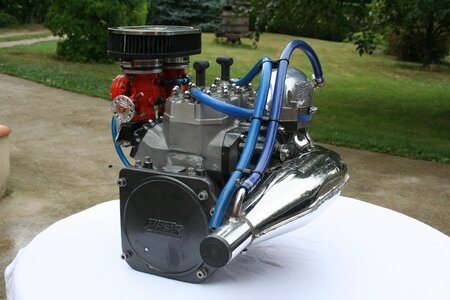I am by no means a "muffler professional", however, most of my conclusions are from experience in building these things for quite a number of years.
the half-pipe chamber on a stock setup is for good, even, overall performance throughout the powerband. that doesn't mean you will get the low-end performance you're looking for with it, and/or top end performance. it all basically boils down to how the engine is set up. a pipe will extract specific types of power out of an engine only IF the engine itself is capable of producing it. you can use a particular pipe to enhance various areas of the powerband, but most of that particularly desired performance is going to mainly exist contingent apon the engines limited capeablities itself.
yes, you take a 550 cylinder and hop it to the moon, high compression, raised port timing, ported for low end, stroked crank, etc... and put a half-pipe to it, and yeah, you will have a monster capeable of swinging a high pitched prop all through the powerband....
...it's not the case with a stock engine.
if you want a stock motor to perform, you're going to have to cut some strings loose from holding it back. that means you're going to have to lower the pitch of the prop to a level that will allow the engine to spool up good BEFORE the pump loads up and begins putting strain on the motors' ability to make power. in other words, get to an area in the powerband where the powerband is less effected by the pump loading up. also, you're going to have to use a pipe that will bring the rpms higher than they will get with a longer chamber, and that is a "shorty". once you get all that setup you can "fine tune" it with water flow.
the reason it's not as much of an issue with the bigger engines is because they make more power on their own to over come power-to-weight ratios, pumploads, etc...
the more power an engine can make, the less you have to compromise in various areas of the setup.

![7198_1[1].jpg](/data/attachments/44/44518-b6b3ba4ea3d323f0eeeec95b51726059.jpg)
